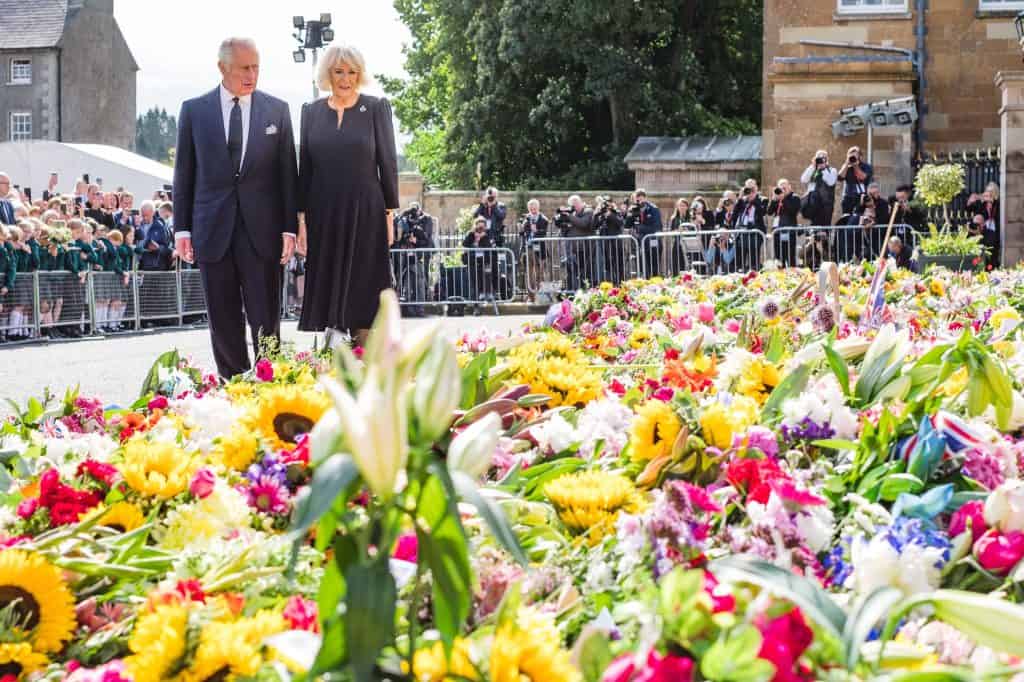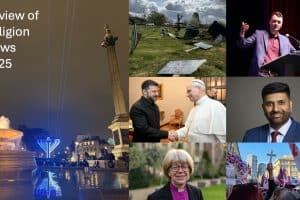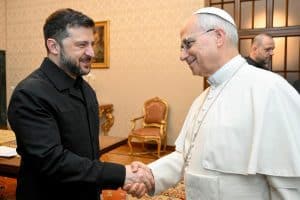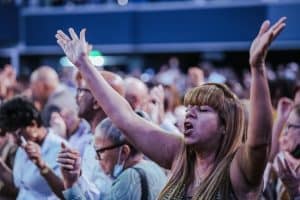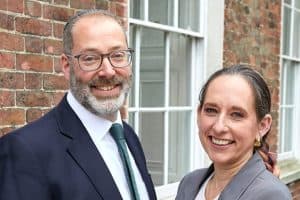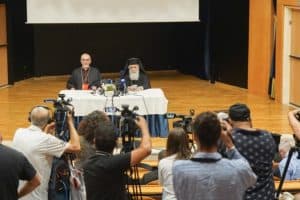The death of Queen Elizabeth II has unleashed a “latent spirituality” as millions of people create shrines at palace gates, gather around religious buildings and fall silent in prayer, to express their shock and grief.
Thousands lined the streets of Edinburgh as the Queen’s coffin was taken from St Giles’ Cathedral for the flight to London.
When the hearse travelled through the city to arrive at Buckingham Palace, thousands more lined the roads, parking in the fast lanes and standing beside their cars to pay respects to the cortege, or standing along the route on a wild wet evening, or crowding outside the gates to the palace.
Professor Ian Bradley, emeritus professor at the University of St Andrews, told a Religion Media Centre online briefing that he had been struck by the number of people making religious gestures as they walked past the Queen’s coffin at St Giles’ Cathedral.
“They’re either crossing themselves, or they are bowing, quite a lot of them are in tears. I think we are seeing the release of a kind of latent spirituality, which is which is still there in in our country,” he said.
The thousands paying respect, watching the processions, laying flowers at palace gates, setting down candles, Paddington bears and even marmalade sandwiches is a religious response, according to Jennifer Uzzell, from Durham University.
“I think shrine is a perfectly appropriate word. It’s not necessarily religion in the philosophical rational way that is associated with belief,” she said. It was an outpouring of ritual instinct as a reaction to shock. “The speed with which this happened has left a lot of people and struggling to adjust.”
This was about understanding religion. “There is a tendency to understand religion as belief, rationality, accepting the truth of a proposition.” But she said there was an increasing awareness in the study of religion that “actually, for most people, most of the time, that is not what’s going on”.
It was more to do with spirituality. “What is actually going on for most people is something that is far more emotional, and far more embodied, than if you like a philosophical approach,” she said.
““They’re either crossing themselves, or they are bowing, quite a lot of them are in tears. I think we are seeing the release of a kind of latent spirituality, which is which is still there in in our country”
– Professor Ian Bradley
With affiliation to Christianity in decline, particularly in the Church of Scotland, which has a programme under way to shut churches, the way crowds are gathering round places of worship shows the importance of place.
Ms Uzzell said: “This is what religion is for a lot of people, it’s that place to go when there’s a great deal of anxiety or uncertainty, which is what we’re experiencing at the moment”.
Professor Stephen Pattison, emeritus professor at the University of Birmingham, said 10,000 people had come to the cathedral in the city centre in the last three days. As a chaplain, he was drawn into conversations, including one about guardian angels.
“The kind of theology that supports this is perhaps secondary to the fact that it’s a public space, right in the middle of the city where people can actually go and be with other people experiencing sometimes a very personal sense of mourning, which they want to share and want to have recognised,” Professor Pattison said.
He had heard people say it was a good thing to have an established church, providing “opportunities for reaching people and allowing something to happen”.
Dr Hisham Hellyer, senior associate fellow at the Centre of Islamic Studies, Cambridge University, suggested it was about more than a place, it was about seeking the divine. He told the briefing: “It’s very clear that what we term as religion isn’t always about a place of worship, a firm commitment to a particular identity.
“It can be often very fluid — sometimes eccentric and eclectic, which isn’t altogether very consistent. But you also have these ways and methods of being very consistent, rooting yourself within your own religious tradition, but seeing echoes of the divine elsewhere.”
The gathering around churches was viewed positively by minority faiths, he said. Research over the past 20 years had clearly shown that within minority religious communities, there was a great deal of support for the church establishment, and the formal connection between the Church of England and the state.
“That would surprise many people, because obviously, they’re not Anglicans, and they don’t want to be Anglicans. But they’re quite aware that if there’s going to be a religion and public life connection, it will be the Church of England, and they’re quite happy with that, as opposed to its absence.”
Journalist and author Catherine Pepinster said it was interesting that people outside the church were drawn into services of remembrance, even if they were unfamiliar with the words and procedures.
“Perhaps part of the reason why they’re drawn into religion at times like this is because more secular bodies haven’t quite found a grammar, a narrative, a way of offering people something,” she said.
For Jennifer Uzzell, the gut instinct on show throughout this national week of mourning, is embodied religion. “There are these — for want of a better term — religious, spiritual responses that seem almost instinctive, even in people that don’t have a specific set of belief. This is how people work.”
(The same panel discussed the meaning and use of the phrase “Defender of the Faith” and there will be a separate report on that part of the discussion)
View the YouTube film of the RMC discussion here >>
The Religion Media Centre annual lecture is by Professor Linda Woodhead, “Considering the Future of Religion in Britain”, touching on points raised in the article here. Tuesday 20 September 6.45pm St Bride’s Fleet Street EC4Y 8AU. Details here

